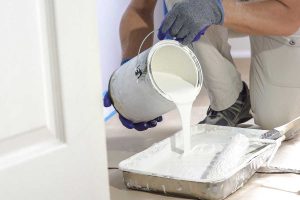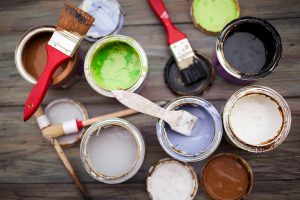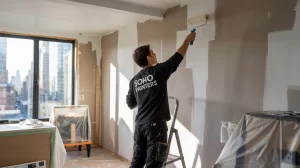Whether you’re short on time or don’t want to spend the extra bucks, primer is often overlooked when it comes to painting projects. But considering it’s recommended to apply a primer before painting walls, will bare metal also need the same treatment or can you get away with just paint?
Since bare metal is a handy and sturdy surface to have in your home, you’ll want to keep it well-protected against the elements as it’s prone to rusting. Whether you’re painting metal furniture, gutters, or sidings, below is a quick guide on how to paint bare metal the right way.
What is the purpose of primer when painting metal?
Technically, you can paint bare metal without primer but applying a layer of it will make the paint look better after the application. Since metal is smooth, the primer will act as an “adhesive” and provide a consistent base so paint won’t slide around the surface and turn out splotchy. This will also cut down the number of paint layers you’ll need to apply, allowing you to save up on paint and time in the long run.
Plus, a layer of primer will also let the paint stick better to the metal surface, lessening chips and peels and extending its lifespan. Whether you’re painting stainless steel, wrought iron, or aluminum, a layer of primer is highly recommended.
What happens if you don’t use primer on metal?
If you choose not to apply primer on a bare metal surface, expect that the paint won’t last as long. The metal will be more susceptible to rust and corrosion since the primer can add an extra layer of protection. Certain types of paint, like water-based latex, can also react badly with the metal and cause it to accelerate rust.
Bare metal also has the tendency to expand and contract depending on the temperature, so cracks and chips will be more apparent without a primer. If the metal surface you’re painting is constantly exposed to the sun, the paint will also fade faster if you don’t apply a primer first.
If the bare metal is also previously painted with a dark color, transitioning to a lighter-colored paint will be more difficult without a primer since the color can appear muddy. To remedy this, applying a white primer over the old paint will make the new hue look more vibrant.
Is paint and primer in one suitable for bare metal?
Priming and painting your project can typically take up a day or two since you need to make sure each layer is dry before you can apply the next one. To cut down on time, paint companies have come up with a formula that combines paint and primer in one and called it self-priming paint, so you won’t take as much time to finish your project.
But as tempting as it might sound, it’s still recommended to use a separate primer for bare metal to provide a higher quality of protection. Especially since metal surfaces are prone to rust and corrosion, a specialty primer that’s made to prevent these issues will always be better.
What primer is best for bare metal?
Since different types of metal will need differing primers, the first thing you’ll need to do is to identify what type you’ll be painting.
Metal surfaces are categorized into ferrous and non-ferrous metals. Where ferrous metals include wrought iron, steel, and cast iron, while non-ferrous ones are made of copper, aluminum, zinc, and stainless steel. To figure out which primer to use, refer to the list below:
- Etching primer – an etching primer is ideal for non-ferrous and galvanized metals since it can penetrate through the galvanized coating without removing its zinc protection. This creates a physical and chemical bond on the metal, protecting it against rust and corrosion.
- Red oxide primer – a red oxide primer is best for ferrous metals that are often exposed to heat, moisture, and humidity. It has a signature red hue because its original formula contained lead, but modern primers have eliminated it from its mixture.
- Zinc-rich primer – a zinc-rich primer is best used on iron and steel surfaces as a rust inhibitor. Its high-zinc content will protect them against damage by corroding in place of the metal.
- Epoxy primer – an epoxy primer can be used on any type of bare metal and is considered one of the most durable. Since it contains resin and a hardener, it can create a tight seal on the surface to prevent oxidation.
How do you paint bare metal surfaces at home?
Once you have the right primer, paint, and tools, you can finally get to the fun part of starting your project. But before you can apply the primer and paint, you’ll need to prep the bare metal surface depending on its current condition. To do this, you can follow the steps below:
1. Wipe away any grease, stain, or dust from the bare metal surface with a damp cloth so you can have a clean slate to work on.
2. If the metal is previously painted, remove old paint and rust with a wire brush, sandpaper, or scraping tool. If the rust has already penetrated beyond the surface, soak the metal in a rust remover following the manufacturer’s instructions.
3. After soaking, washing, and drying the metal, you’ll need to scuff up its surface to let the primer and paint adhere better. You can use a scuffing pad or sandpaper to do this.
4. Once you’re satisfied, you can then apply a coat of primer depending on the type of metal you’re working with. Make sure to let the primer dry completely before you start painting.
Need help with painting bare metal surfaces?
If you’re still unsure about the proper method of painting bare metal, there’s no need to waste your time and money and let the professionals do it for you. Soho Painters has a team of experienced painters that are ready to jazz up your home with guaranteed excellent results. Whether you’re looking to do the exterior or interior of your home, they’re equipped to transform your walls. For more inquiries, contact them now to get a free estimate!





